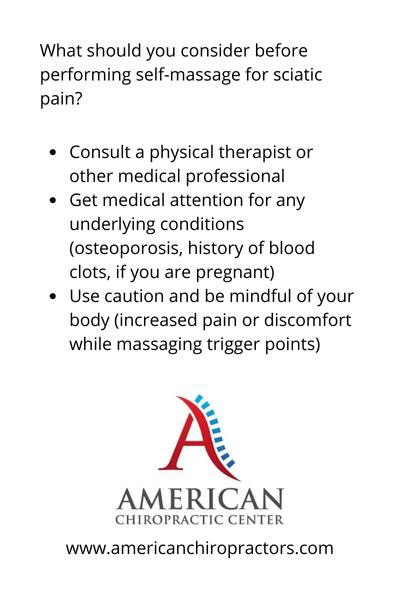Sciatica
How Do I Massage Sciatica Trigger Points?

Sciatica is a common condition that can cause pain, discomfort, and difficulty moving. It is caused by irritation or compression of the sciatic nerve, which is the largest nerve in the body and runs from the lower back through the buttocks and down the legs. Massaging trigger points, or tight knots of muscle, can help to relieve pain and discomfort associated with sciatica.
Read More About How Do I Massage Sciatica Trigger Points

More Things To Know About How Do I Massage Sciatica Trigger Points
In this article, we will discuss the steps and techniques for massaging sciatica trigger points, as well as tips for ensuring a safe and effective massage. Whether you are a seasoned massage therapist or simply looking for ways to manage your own pain and discomfort, this article has something for everyone.
How Do I Massage Sciatica Trigger Points?

Sciatica is a condition that results from irritation or compression of the sciatic nerve, which is the largest nerve in the body and runs from the lower back through the buttocks and down the legs. Massaging trigger points, or tight knots of muscle, can help to relieve pain and discomfort associated with sciatica.
Here are some steps and tips for massaging sciatica trigger points:
- Find the trigger points: To massage sciatica trigger points, it is essential to locate them first. Trigger points are usually found in the muscles of the lower back, buttocks, and legs. To locate them, you can use your fingers to feel for tight knots or areas of tenderness in these muscle groups.
- Use the right amount of pressure: When massaging trigger points, it’s important to use the right amount of pressure. If the pressure is too light, it won’t be effective. If the pressure is too strong, it can cause more pain and discomfort. A good rule of thumb is to use the amount of pressure that allows you to feel a gentle stretch in the muscle, but not so much that it causes pain.
- Massage in a circular motion: Once you’ve located the trigger points, use your fingers to massage them in a circular motion. Start with small, slow circles and gradually increase the size and speed of the circles as you become more comfortable.
- Use massage oil or cream: Massaging with oil or cream can help to reduce friction and make the massage more comfortable. You can use a store-bought massage oil or cream, or you can make your own by mixing a few drops of essential oils with a carrier oil such as coconut oil or jojoba oil.
- Take breaks as needed: Massaging trigger points can be physically demanding, so it’s important to take breaks as needed. If you start to feel tired or sore, take a break and rest for a few minutes before continuing.
- Consider using a massage tool: In addition to using your fingers, you can also use a massage tool such as a foam roller or massage ball to help reach and massage deeper muscles. These tools can be especially helpful if you have a lot of tightness or knots in your muscles.
- Stretch after massaging: Stretching can help to loosen up tight muscles and improve flexibility, which can help to reduce pain and discomfort associated with sciatica. After massaging the trigger points, take a few minutes to stretch the muscles of the lower back, buttocks, and legs.
It’s important to note that massaging trigger points should not be used as a replacement for medical treatment. If you are experiencing pain or discomfort associated with sciatica, it’s important to speak with a healthcare professional for proper diagnosis and treatment.
Is Self-Massage Safe?
While self-massage can be a helpful way to relieve the pain and discomfort associated with sciatica, it is not a replacement for medical treatment.
If you are experiencing pain or discomfort associated with sciatica, it is important to speak with a healthcare professional for proper diagnosis and treatment. A physical therapist can help to determine the underlying cause of your sciatica and develop a treatment plan that is tailored to your specific needs.
It’s also important to note that massaging trigger points can be physically demanding and may not be suitable for everyone. If you have any underlying health conditions, such as osteoporosis or a history of blood clots, or if you are pregnant, it is important to consult with a healthcare professional before attempting to massage your own trigger points.
If you do decide to try self-massage for sciatica, it is important to use caution and be mindful of your body. If you experience any increased pain or discomfort while massaging your trigger points, stop immediately and consult with a healthcare professional.

Doctor Osvaldo Pepa, Neurosurgery Service Physician at Hospital San Martin, La Plata, Argentina. I graduated last November 16, 1984 with a Medical Degree at the Universidad Nacional de La Plata. The Medical Board of La Plata, District 1, licensed me as a Neurosurgeon in 1990. I hold a Provincial and National License and an active member of the Neurosurgery Society of La Plata, World Ozone Therapy Federation, and Inter American Society of Minimally Invasive Surgery.

























